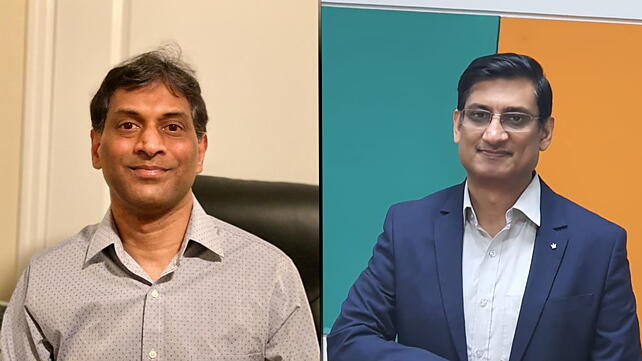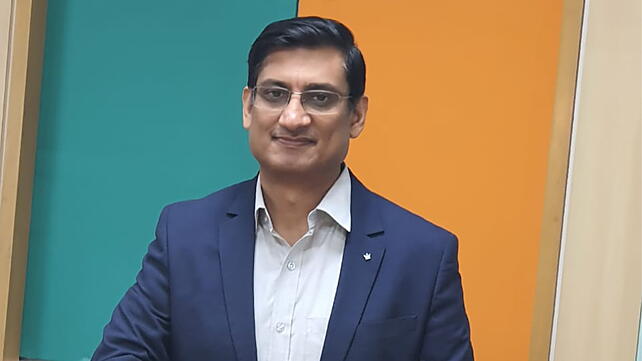
As the President of Visteon India, Aashish Bhatia is responsible for strategising and leading a profitable growth for Visteon in India. In this role, he is also responsible to drive productivity and capability of product development teams for domestic as well as global programme of Visteon Corporation. He has a Bachelor’s degree in Electronics Engineering; a Master’s degree in Design Engineering from IIT Delhi, and has successfully completed an executive management programme from IIM Bangalore.
Balaji Gudavalli, Global VP – Engineering & Product Development, Visteon leads the development of the cockpit software platform. He oversees the strategy, development and delivery of Visteon’s cockpit software platform, encompassing SmartCore™, infotainment, driver monitoring, driver information, OS/BSP and RenderCore. He is based in Van Buren Township, Michigan. Balaji has a Bachelor of Technology degree in Electronics & Communications from the National Institute of Technology, Warangal (India).
Let us take a step back to understand how 2020 was for Visteon India, considering we were hit by the COVID pandemic. How does it stand today and what is your forecast for the future?
AB: The past year for Visteon was as it was for everyone. We have had our own share of lessons learnt on how to do business and how to continue delivering business commitments. From the customer’s point of view, there was continued interest in making the investments on the newer technologies. There were no major delays in product launches. In fact, 2020 was a year of substantial launches for Visteon, including Android-based infotainment for VW Nivus. We also specifically focused on developing next-gen products and technology to be launched next year.
We continue to see a very ambitious outlook from the OEMs as they continue to embrace and adopt new technologies. They are keeping the consumer at the centre of the whole value proposition. There is also continued interest in investing in an interconnected ecosystem. From Visteon’s perspective, we see OEMs leaning towards integrated or connected cockpit domain controller systems, and subsequently delivering value to the consumers through these offerings.
Balaji, how did you approach innovation in this phase, considering your overall approach to innovation?
BG: That’s a good question. If you look at it, as Aashish said, safety of our employees, business continuity and executing the existing projects without much delay was a priority. And, we were able to successfully do that.
On the innovation front, we are aware of the chipset and software roadmaps; and we have factored those in while devising our business strategy and technology roadmap. In Visteon, we meet once in six months to take a comprehensive look at where we are in terms of the technology roadmap, and where we want to go. We discuss whether it makes sense to go for a custom chip, or to align with a specific vendor, etc. Based on that, we take steps in the right direction. The team also likes that because they get to work on the best technologies.
I worked in the cell phone industry for a couple of decades, and I see that the automotive industry is pretty much following the same curve. Big players like Qualcomm and Google gaining foothold in the automotive industry, bringing talent and innovation. Therefore, the benchmark is getting higher and there is a lot of skillset upgrade we need to do to catch up with that. At Visteon, there is a lot of focus on innovation, executing it right and nurturing talent for things that we aspire to do in the next two years.
In the Indian context, how do OEMs and end-consumers perceive innovation? What does it look like in years to come?
AB: From an OEM standpoint, they are keen to work with us on the next-gen cockpit electronics, which is based on three main pillars – connectivity, safety and security. In addition to large displays and rich graphics, we see an increased adoption of voice and, the apps invading the vehicle cockpit. These will define the cockpit of the future.

This revolves around the idea of digitisation, which is now transforming cockpit electronics. We are focused on the mass-market aspect, and the premium end of that. Having said that, there are overarching consumer needs across different segments, which typically gain a high degree of importance; and those are safety and security of the data, and mirroring of the smartphones on their digital cockpit.
How do you view the mobility ecosystem, and what is the approach you take to engineering and product development?
BG: We are going from a technology platform to a solution platform to an app ecosystem. So, it’s an end-to-end ecosystem that we’re creating – one, inside the car ecosystem, and the other outside the car ecosystem. We’re actually more focused on inside the car ecosystem, where we have more control. Traditionally, we have been collaborating only with the OEMs.
But today, we’re also observing other industries, including 5G, V2X, and other intelligent technologies and infrastructure. In that context, there are many use cases driven by OEMs. We also know that we need to be ahead of the curve, and hence doing things with the right plan and talent in place.
It is also important to understand how Visteon as an organisation is democratising technology, both in the global context as well as the Indian context?
AB: Talking about democratisation of technology, we have a strategy for hardware reuse; we also need a very fundamental approach of having a reuse strategy for software. That will enable us faster time to market and also give a better, stable value proposition.
As products are getting more and more complex, most of our customers are looking for first-time-right. They are also looking at reuse so that there is more stability and security in the solution. The third thing they are looking at is the customisation in the local and regional context.
In that context, one of the technologies that is impacting us is artificial intelligence. The use of AI, voice or voice-based system has seemed the most natural and safe mode for the driver to interact with cockpit electronics. That is another excellent example, where we see the need to have a more regional focus.
Of course there is democratisation in the sense of having these building blocks, but there have also been regional applications of these technologies.
BG: We call it a localisation, right? There’s democratisation and there is localisation. We are looking at the trends in the industry. We don't want to reinvent the wheel. There is a proven Android ecosystem and there’s a corresponding platformisation that happens. I’m one of the lead for software platforms inside Visteon, and we push the reusability of software components so that we can focus on differentiating them.
There’s a lot of specific effort we put in to bring that mind-set change. And that’s happening at a faster pace. We’re also hiring the right teams to bring in that mind-set change. If you look at a high level, there’s a lot of talent gap in the automotive industry compared to the number of technologies we have to bring-in and make it work. That’s also the key to make sure we are ahead of the game and are ready for the upcoming challenges.
Visteon has been investing a lot in talent and creating a lot of solutions out of the Indian market, be it in the context of AI or deep learning. How is Visteon taking advantage of the engineering talent that is available in the country?
BG: We have certain special projects, such as our own internal DriveCore system. There are a lot of deep learning, artificial intelligence, machine learning and training algorithms on that. So that's number one. We also have solutions for driver monitoring, cockpit interior sensing, and we’re also looking at electrification and battery management systems. We’re building a strong roadmap as well as doing strong pre-work on the things that we want to make sure we have.
AB: In the context of artificial intelligence, we are seeing two applications – one is voice-based and the other is camera support. Our voice-based solutions offer natural language recognition and smart assistants; and our camera-based solutions offer driver monitoring, safety and ADAS features such as Lane Keep Assist.
We’re also focusing on vertical integration by investing on AI-based tools – for voice recognition and vision processing — that will assist OEs with their natural language processing needs, both on-board and off-board. That way, it will help meet the constant demand of cloud connectivity and with the help of AI, consumers will have a good, seamless conversation with the cockpit.
How important is the role of collaboration in creating solutions across the spectrum? Could you share some of the collaborative work you’ve done?
BG: We are collaborating with a few Indian OEMs. Industry is transitioning from drive-by-ECU mode to a centralisation of CPUs (at the hardware level). There are also standard Linux and Google stacks that are being pushed, and then there are the app players. That's the landscape today.

Essentially, it’s a very complex system. Take the Daimler S-Class for instance, which has 30 million lines of code. If we take that into context, we need a lot of collaboration between internal teams; we need to work like a pure software company to make sure our software and the underlying platform are stable.
AB: Collaboration is not an option, but a necessity now! There is a unique need of cross-sector and cross-industry collaboration to build these engineering solutions. Daimler-Uber and Hyundai-Cisco are examples of such industry collaborations in recent times.
We are looking at the confluence of deep automotive experience and disruptive technology that we can bring in. And if we can fulfil consumer needs and demands at a very high speed, that would be truly transformational. If we’re able to deliver this value proposition to the ecosystem, I think that will be the key to make ourselves relevant to the business needs.
What are some of the key trends or solutions consumers can expect coming out from Visteon?
AB: Visteon will continue to deliver front-end technology. Visteon has been in India for more than two decades, with over 1,500 engineers that are located in our technical centres in India. Balaji has a very large team with a significant portion of his design and development work being done out of India. We engineer to innovate and innovate to make these products not only for the Indian OEMs, but also for the global OEMs.
From our stable, you’d see more Android-based infotainment systems, digitisation and transformation of the digital cluster, increased focus on the size, shape and type of displays. Also, introduction and use of artificial intelligence on the voice and image processing side of business, and increased use of the app store in the automotive context.
What is that one technology that excites you the most, when we think about the future?
BG: Our battery management system is a new technology and has a lot of potential. We’re very excited about that as a company. In general, the AI and ML are going across all the products. Also, we want to continue being the leader in cockpit domain controllers.
Watch the full video here: